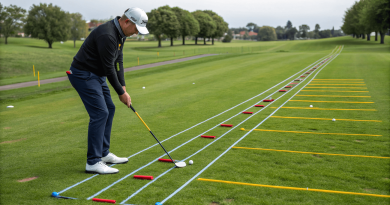Common Golf Swing Flaws and How to Fix Them
Golf is one of those games that, at a glance, may appear very simple, but in fact is maddeningly difficult to master. For many golfers, one of the most daunting challenges on the course is the development of a consistent and powerful swing that sends the ball exactly where you want it to go each and every time. Some swing woes are so common that even experienced players can’t correct them. These issues are part of the Common Golf Swing Flaws and How to Fix Them, which can prevent you from playing your best game.
What We Cover In this Post
Gripping the Club Too Tightly
Problem:
- Many golfers grip the club too tightly, and those who do so do so under the misconception that they’ll get more control. But the truth is that holding on too tight does not allow for flexibility and leads to a stiff swing.
Fix:
- Hold the club lightly, as if you’re holding a small bird — you want it to remain in your hand without squeezing it. Mild hold allows the club to swing more freely and gives you a more fluid swing.
Poor Posture at Address
Problem:
- Poor posture is hard on balance, but it has a lot to do with your swing path as well. Staying too vertical or leaning back too much can produce off-center shots.
Fix:
- Stand with your feet hip-width apart. Gently bend forward from your hips (not your back), relax your knees and allow your arms to dangle. A more even approach and a more purposeful swing.
Also Read: Best Golf Swing Drills for Beginners
Lifting the Head Too Early
Problem:
- Raising your head before you’ve hit the ball results in thin or missed shots. It just happens a lot when you’re kind of anxious to see where the ball goes.
Fix:
- Keep watching the rear of the ball until the stroke is completed. Pretend there’s a coin under the ball and don’t look up until you “hear” the ball hit.
Swinging Too Hard or Too Fast
Problem:
- In attempting to crush the ball, you risk getting out of your rhythm and losing control.
Fix:
- Focus on timing, not power. Go with 1-2-3 for rhythm, 1 for backswing, 2 for top, and 3 for follow-through. Smooth and steady often goes further than hot and bothered.
Also Read: Swing Path vs Clubface: What Matters Most
Over-the-Top Swing Path
Problem:
- This occurs when the club goes off plane outside the target line on the downswing. It causes slices and pulls.
Fix:
- Work on an “inside-out” swing. Set up an alignment stick or towel next to the ball, which will help keep the club on the proper path. And get your weight leaning forward on the downswing to help you avoid swinging from the outside.
Also Read: Golf Swing Mechanics
Lack of Follow-Through
Problem:
- The majority of golfers attempt to halt the downswing immediately after the ball is hit, resulting in a lack of distance, poor direction and poor contact.
Fix:
- Let your swing finish naturally. At impact, your chest should be facing towards the target, with your back foot off the ground. Develop this habit by practicing in slow motion, with full swings.
Swaying Instead of Rotating
Problem:
- Some golfers don’t rotate their body at all—they sway side to side. This results in inconsistent ball hitting.
Fix:
- Rotate in your shoulders and hips, but keep the lower half of your body still. Think of rotating around your spine, not moving to the left or to the right. Standing in front of a mirror or videotaping yourself can help you observe if you’re swaying.
Also Read: Understanding Golf Swing Plane Angles
Poor Weight Transfer
Problem:
- Failure to transfer your weight correctly is a leading cause of weak shots or slices.
Fix:
- You want to get out of the sand and have the ball stop – not go into it. Some golfers lean to the left to find more bottom (and will most likely hit the ball fat), but in doing so you will be gaining weight on your front foot. As you swing forward, transfer the weight to your front foot. Do some slow-motion swings to better feel this transfer.
Too Much Tension in the Body
Problem:
- Stiff shoulders, arms, or legs can make your swing appear robotic.
Fix:
- Stay relaxed. Do some stretching before you play, and take a few deep breaths. The looser your body, the more comfortable your swing will be.
Inconsistent Ball Position
Problem:
- If the ball is too far forward or back in your stance, it changes the angle of the clubface at impact.
Fix:
- For most iron shots, the ball should be in the center of your stance. For drivers, move it an inch or so forward (toward your front foot). It also helps establish a good ball position to make solid contact with the ball every time.
The Last Piece of Advice to Correct Your Swing Flaws
- Film Your Swing: Seeing yourself makes you aware of mistakes you may not notice.
- Fix One Thing at a Time: You can’t fix everything at once. Concentrate on one fault at a time during a practice session.
- Employ Training Aids: From swing trainers to alignment sticks, these training aids will help direct your improvement.
- Get Personalized Instructions: A teaching pro can provide individualized tips to help you fix your swing quicker.
Also Read: How to Finish Your Golf Swing Like a Pro
Your swing doesn’t have to take forever to fix. Well, now that you know what some of the most common golf swing flaws are and how to fix them, it’s time to practice with a purpose. And mind you, small changes can make big improvements. The most important thing is to be patient and relaxed and most of all… Have fun!



